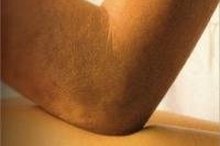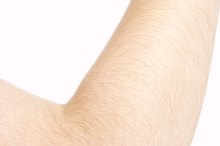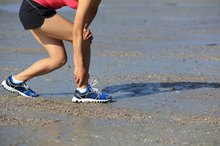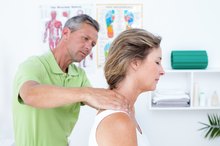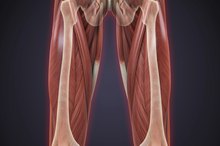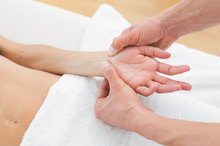Elbow Pain After Lifting Weights
Lifting weight can lead to what’s commonly referred to as overuse injuries. Two of the more common are elbow injuries called medial epicondylitis and lateral epicondylitis -- both forms of tendinitis. The location of the pain can help determine which type you’re experiencing, but treatment is typically the same for both conditions.
If you are experiencing serious medical symptoms, seek emergency treatment immediately.
Medial Epicondylitis
The pain you’re feeling in your elbow could be the result of medial epicondylitis, especially when the pain emanates from the inside of the elbow. Otherwise known as “golfer’s” elbow, this type of injury can occur from lifting weights when you use improper technique 1. What happens is you eventually overload the muscles and tendons of the elbow, which leads to irritation, inflammation and pain.
Lateral Epicondylitis
How to Treat Elbow Tendonitis
Learn More
If the pain is felt along the outside of elbow, this is often an indication of lateral epicondylitis, or “tennis” elbow. In this situation, the repetitive movements used while lifting weights can irritate and subsequently inflame the muscles and tendons of your elbow. Like medial epicondylitis, poor form typically plays a role, but lifting too heavy of weights or completing too many reps can also contribute to this injury.
Treatment
Treating either one of these injuries frequently comes down to self-care measures. Given enough time, both forms of epicondylitis can heal on their own. Most medical professionals recommend resting your elbow, so avoid any activity that triggers the pain. Icing the affected elbow is also beneficial. The cold helps to reduce swelling, which should ease any discomfort. Only apply the ice, however, in 20-minute increments. Besides resting and icing, you should also wrap and elevate the elbow to further limit inflammation.
- Treating either one of these injuries frequently comes down to self-care measures.
- The cold helps to reduce swelling, which should ease any discomfort.
Physical Therapy
Elbow Hyperextended Treatment
Learn More
If self-care fails to improve epicondylitis, talk to a doctor. You may need physical therapy to correct your condition. A physical therapist can work with you to determine what’s causing the injury as well as establish a series of exercises to stretch and strengthen the muscles and tendons of your forearm. Though you’re feeling the pain in your elbow, underdeveloped muscles of the forearm can lead to stress along the anterior medial epicondyle or lateral epicondyle, thereby causing golfer’s elbow or tennis elbow, respectively 1.
- If self-care fails to improve epicondylitis, talk to a doctor.
- A physical therapist can work with you to determine what’s causing the injury as well as establish a series of exercises to stretch and strengthen the muscles and tendons of your forearm.
Related Articles
References
- MayoClinic.com: Golfer’s Elbow
- American Academy of Family Physicians: Evaluation of Overuse Elbow Injuries
- American Academy of Family Physicians: Weight-Training and Weight-Lifting Safety
- Amin NH, Kumar NS, Schickendantz MS. Medial Epicondylitis: Evaluation and Management" J Am Acad Orthop Surg. 2015 Jun;23(6):348-55.
- Jobe, FW; Ciccotti, MG. "Lateral and Medial Epicondylitis of the Elbow" J. Am. Acad. Ortho. Surg., Jan 1994; 2: 1 - 8.
Resources
Writer Bio
Based in Minneapolis, Minn., Dana Severson has been writing marketing materials for small-to-mid-sized businesses since 2005. Prior to this, Severson worked as a manager of business development for a marketing company, developing targeted marketing campaigns for Big G, Betty Crocker and Pillsbury, among others.
